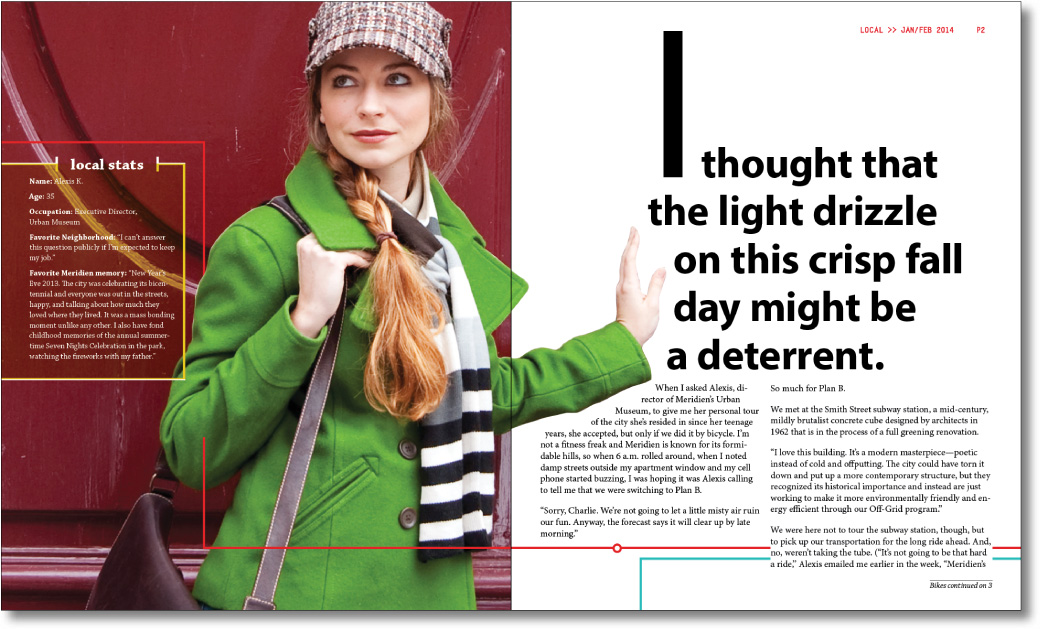5. Flowing Text
Lesson Overview
In this lesson, you’ll learn how to do the following:
• Import and flow text into an existing text frame.
• Apply paragraph styles to text.
• Adjust line breaks.
• Create frames manually while flowing text.
• Add frames automatically while flowing text.
• Resize text frames automatically.
• Create linked frames automatically.
• Add pages and linked frames automatically while flowing text.
• Make a jump line to indicate where an article continues.
• Add column breaks.
This lesson will take about 45 minutes to complete.
Download the project files for this lesson from the Lesson & Update Files tab on your Account page at www.peachpit.com and store them on your computer in a convenient location, as described in the “Getting Started” section of this book.
Your Account page is also where you’ll find any updates to the chapters or to the lesson files. Look on the Lesson & Update Files tab to access the most current content.
Adobe InDesign provides methods for flowing short pieces of text into existing frames, creating frames while flowing text, and adding frames and pages while flowing text. This makes it easy to flow copy for anything from a catalog to a magazine article to an ebook.
Getting started
In this lesson, you’ll work on a magazine article in progress. The design of the opening spread of the article is almost finished, and several pages are ready for text. While working on this article, you will experiment with various text-flow methods and create a “jump line” to indicate the page on which an article continues.
1. To ensure that the preference and default settings of your Adobe InDesign program match those used in this lesson, move the InDesign Defaults file to a different folder following the procedure in “Saving and restoring the InDesign Defaults file” on page 3.
![]() Note
Note
If you have not already downloaded the project files for this lesson to your computer from your Account page, make sure to do so now. See “Getting Started” at the beginning of the book.
2. Start Adobe InDesign. To ensure that the panels and menu commands match those used in this lesson, choose Window > Workspace > [Advanced], then choose Window > Workspace > Reset Advanced.
3. Choose File > Open, and open the 05_Start.indd file, in the Lesson05 folder, located inside the Lessons folder within the InDesignCIB folder on your hard disk. If the Missing Fonts dialog box displays, click Sync Fonts.
4. Choose File > Save As, rename the file 05_FlowText.indd, and save it in the Lesson05 folder.
5. Choose View > Display Performance > High Quality Display.
![]() Note
Note
Flowing text is one of the first things you will do when designing a document. In this lesson, you will finish working on this document when all the text fits. For the final publication, you would add many more pictures, captions, and design elements.
6. If you want to see what the finished document looks like, open the 05_End.indd file in the same folder. Choose View > Display Performance > High Quality Display. You can leave this document open to act as a guide as you work.

7. When you’re ready to resume working on the lesson document, display it by clicking its tab in the upper-left corner of the document window.
Flowing text into an existing frame
When you import text, you can flow it into a new frame or an existing frame. If the frame is empty, you can click the loaded text icon in it to flow the text. On the leftfacing page of the opening spread of this article, an empty sidebar box with the subhead “local stats” is ready for the text describing the woman on the page. You will import a Microsoft Word document into this frame, apply a paragraph style, and try two methods for fixing orphans, which are defined here as a single word on a line. Orphans are also known as “runts.”
![]() Tip
Tip
InDesign provides many features for automatically and manually controlling how text flows through columns and frames. These include the following paragraph formats Keep With Previous, Keep With Next, and Keep Lines Together, along with Column Break and Frame Break characters (Type > Insert Break Character).
1. Zoom in to comfortably view the sidebar text frame on the left-facing page of the opening spread. Make sure no objects are selected.
You edit text with the Type tool and thread (link) text frames with the Selection tool, but it does not matter what tool is selected when you import text.
2. Choose File > Place. At the bottom of the Place dialog box, make sure the three options are deselected: Show Import Options, Replace Selected Item, and Create Static Captions.
3. Locate 05_LocalStats.docx, in the Lesson05 folder, and then double-click it.
The pointer becomes a loaded text icon (![]() ), previewing the first few lines of text in the story you are placing. When you move the loaded text icon over an empty text frame, parentheses enclose the icon (
), previewing the first few lines of text in the story you are placing. When you move the loaded text icon over an empty text frame, parentheses enclose the icon (![]() ).
).
4. Position the loaded text icon over the placeholder text frame (below the text frame containing the “local stats” subhead).

5. Click to place the text.
6. Using the Type tool (![]() ), click in the frame to edit the text. Choose Edit > Select All to select all the text in the frame.
), click in the frame to edit the text. Choose Edit > Select All to select all the text in the frame.
7. Choose Type > Paragraph Styles to open the Paragraph Styles panel.
8. Click on the paragraph style White Sidebar Text. (If necessary, scroll through the Paragraph Styles panel to locate it.)
A plus sign (+), which indicates local overrides (variations from the paragraph style), displays next to the paragraph style name because some of the selected text is bold. While sometimes local overrides are undesirable, in this case they are fine.
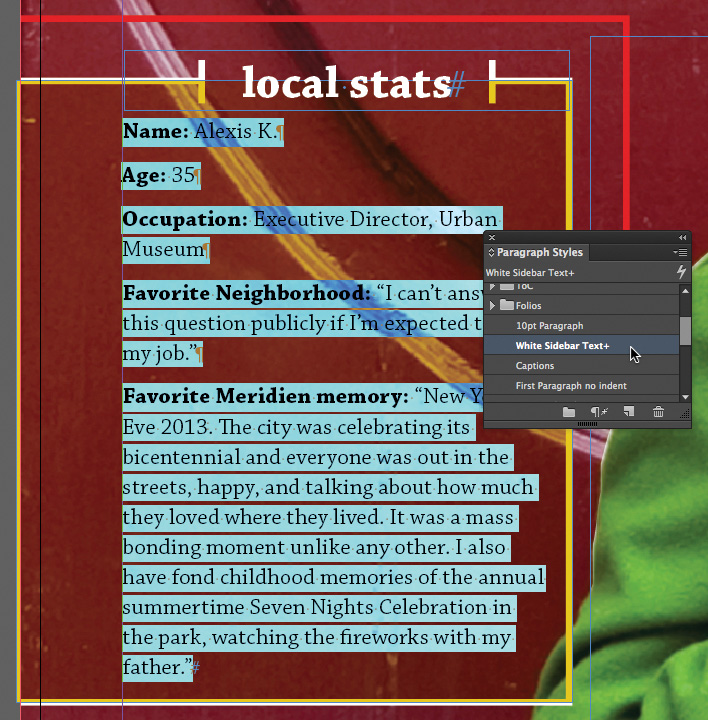
![]() Tip
Tip
One method for clearing all local overrides—to ensure that text formatting precisely matches a style—is to select Clear Overrides from the Paragraph Styles panel menu. For more information about styles, see Lesson 9, “Working with Styles.”
Now, you will fix the orphan in the third paragraph, which starts with “Occupation.” To do this, you will enter a forced line break.
9. Zoom in as necessary to read the text.
![]() Tip
Tip
If you forget the keyboard shortcut for a forced line break, you can choose Type > Insert Break Character > Forced Line Break.
10. Using the Type tool, click right before the word “Urban” in the third paragraph of the sidebar text. Press Shift+Enter (Windows) or Shift+Return (Mac OS) to force “Urban” to the next line within the paragraph.

Next, you will fix the orphan in the last line of the sidebar using tracking, which adjusts the amount of space between selected characters.
11. Scroll down as necessary to view the last paragraph, which starts with “Favorite Meridien memory.” Using the Type tool, click four consecutive times in the paragraph to select all the text.
12. Choose Type > Character to display the Character panel. Type –10 in the Tracking box and press Enter or Return.

13. Choose Edit > Deselect All, then choose File > Save.
![]() Tip
Tip
When the Type tool is loaded with multiple text files, press the arrow keys on the keyboard to change which text file is loaded for placement, and press Esc to remove a text file from the loaded text icon.
Flowing text manually
The process of taking an imported text file and flowing it across several connected text frames is called threading text. InDesign lets you flow text manually for greater control, flow text automatically to save time, and flow text while adding pages.
![]() Tip
Tip
You can create columns by threading individual text frames or by dividing text frames into columns using the General tab of the Text Frame Options dialog box (Object menu). Some designers prefer separate text frames for more layout flexibility.
In this exercise, you will flow the feature article text into the two columns at the bottom of the right-facing page. First, you will select a Word file to import into the existing text frame in the first column. Second, you will thread the first text frame to the second text frame. Finally, you will create new text frames on the third page of the document to contain more of the text.
1. Choose View > Fit Spread In Window to locate the two text frames at the bottom of the right-facing page. Zoom in as necessary to view these text frames.
2. Using the Type tool (![]() ), click in the text frame at the left immediately below the woman’s hand.
), click in the text frame at the left immediately below the woman’s hand.

3. Choose File > Place.
4. Locate and select 05_Long_Biking_Feature_JanFeb2014.docx, in the Lesson05 folder.
5. Check Replace Selected Item at the bottom of the Place dialog box, and then click Open.
The text flows into the existing frame in the left column. Notice that the text frame includes an out port in the lower-right corner. The red plus sign (+) indicates that some of the text you imported is overset, meaning that not all of the text fits into the existing text frame. You will now flow the additional text into another text frame in the second column.
![]() Tip
Tip
If you change your mind and decide you don’t want to flow overset text, you can press Esc or click any tool in the Tools panel to cancel the loaded text icon. No text will be deleted.
6. Using the Selection tool (![]() ), click in the text frame’s out port to load the text icon, as shown. (If necessary, first click the frame to select it, then click the out port.)
), click in the text frame’s out port to load the text icon, as shown. (If necessary, first click the frame to select it, then click the out port.)

7. Position the loaded text icon (![]() ) anywhere in the text frame at the right and click.
) anywhere in the text frame at the right and click.
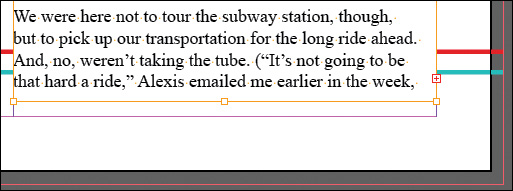
![]() Tip
Tip
As you flow text, the Selection tool’s cursor changes to various loaded text icons.
The text flows into the second column. The out port in the text frame at the right contains a red plus sign (+), indicating that there is still overset text.
8. Choose File > Save. Leave the page in this position for the next exercise.
Creating text frames while flowing text
Now, you will try two different text flow methods. First, you will use semi-autoflow to place text into a column. Semi-autoflow lets you create threaded text frames one at a time. The pointer becomes a loaded text icon that automatically reloads after each column is placed. After that, you will use the loaded text icon to manually create a text frame.
![]() Tip
Tip
The loaded text icon changes slightly in appearance, depending on whether you are threading text manually or using semi-autoflow or autoflow.
1. Using the Selection tool (![]() ), click the out port of the text frame in the second column on page 2. This loads the text icon with the overset text.
), click the out port of the text frame in the second column on page 2. This loads the text icon with the overset text.
You will create new text frames on page 3 to contain more of the text. Guides indicate where to place the text frames.
2. Choose Layout > Next Spread to display pages 3 and 4, then choose View > Fit Spread In Window.
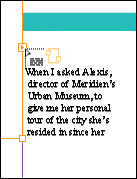
When the loaded text icon is active, you can still navigate to different document pages or add new pages.
3. Position the loaded text icon (![]() ) in the upper-left corner where the guides intersect, as shown below. For proper placement, watch for the black arrow in the loaded text icon to turn white.
) in the upper-left corner where the guides intersect, as shown below. For proper placement, watch for the black arrow in the loaded text icon to turn white.

4. Hold down the Alt (Windows) or Option (Mac OS) key and click.
The text flows into the first column. Because you held down Alt or Option, the pointer is still a loaded text icon, ready for you to flow text into another frame.
5. Release the Alt or Option key, and position the loaded text icon (![]() ) in the second column indicated by the guides.
) in the second column indicated by the guides.
6. Drag to create a frame within the purple column guides in the right-hand column.
A sketch of the design for this article shows that additional design elements will go above and below the two new columns. So you will adjust the height of the frames to fit within the horizontal cyan guides.
![]() Note
Note
The amount of text that fits in the frame may vary according to the specific font that is active on your system. In a print environment, it’s important that everyone uses exactly the same fonts. For this lesson, the fonts in use are not important.
7. Using the Selection tool, drag the top and bottom of each text frame to fit within the cyan guides, as shown.

Clicking the loaded text icon creates text frames within the column guides and flows the text (left). You will manually reposition the columns as indicated by guides on the page (right).
Text remains overset, as indicated by the red plus sign (+), in the lower-right corner of the second text frame. You will fix this later.
8. Choose File > Save. Leave the page in this position for the next exercise.
Flowing text automatically
You will use autoflow to place the remaining text on the next spread. When you autoflow text, InDesign automatically creates new text frames within column guides on subsequent pages until all of the overset text is placed.
1. Using the Selection tool (![]() ), click the out port in the lower-right corner of the text frame in the second column on page 3. This loads the text icon with the overset text. (If necessary, first click the frame to select it, then click the out port.)
), click the out port in the lower-right corner of the text frame in the second column on page 3. This loads the text icon with the overset text. (If necessary, first click the frame to select it, then click the out port.)
2. Choose Layout > Next Spread to display pages 5 and 6.
3. Position the loaded text icon (![]() ) in the first column on page 5, roughly where the column and margin guides intersect. (You will adjust the height of the frames later.)
) in the first column on page 5, roughly where the column and margin guides intersect. (You will adjust the height of the frames later.)
![]() Tip
Tip
When you create a text frame by clicking with the loaded text icon, InDesign creates the new text frame as wide as the column where you click. Although these frames are placed within the column guides, you can move, resize, and reshape these text frames as necessary.
4. Hold down the Shift key and click.
Notice that new text frames are added to pages 5 and 6 within the column guides. This is because you held down the Shift key to autoflow text. All of the text in the story is now placed. However, you will resize these text frames to fit within the horizontal cyan guides.
![]() Tip
Tip
To adjust how text flows within frames, you can enter break characters such as Column Break and Frame Break (Type > Insert Break Character).
5. Using the Selection tool, drag the top and bottom of each text frame to fit within the cyan guides, as shown.

As you can see, the text is still overset.
6. Choose File > Save. Leave the page in this position for the next exercise.
Creating threaded frames automatically
To speed up the creation of column-width linked text frames, InDesign provides a shortcut. If you press the Right Arrow key as you drag the Type tool to create a new text frame, InDesign automatically divides the text frame into multiple threaded frames. For example, if you press the Right Arrow key once while creating a text frame, the text frame is divided once into two text frames of equal width. If you press the Right Arrow key five times, the text frame is divided five times, resulting in six columns of equal width.
![]() Tip
Tip
In addition to threading frames to flow already placed text, you can pre-thread empty text frames. Using the Selection tool, click a frame’s out port, then click anywhere in the next frame. Repeat this process until all the frames are threaded.
You will now add a page to the end of the document and flow the remaining overset text into a subdivided text frame.
1. Choose Window > Pages to display the Pages panel.
2. In the upper portion of the Pages panel, scroll to locate the FEA-2 Col Feature master spread.
3. Select the left-facing master page and drag it down to the lower portion of the Pages panel. Release the mouse button when the master page icon is positioned under page 5.
4. Double-click the page 7 icon to center the new page in the document window.
5. Select the Type tool (![]() ) and position it in the first column on page 7, roughly where the vertical purple guide and the horizontal cyan guide intersect.
) and position it in the first column on page 7, roughly where the vertical purple guide and the horizontal cyan guide intersect.
![]() Note
Note
If you accidentally press the Right Arrow key more than once—producing more than two threaded text frames—choose Edit > Undo, then try again. You can also remove text frames by pressing the Left Arrow key as you drag.
6. Drag the Type tool down and to the right to create a text frame that spans the width of both columns. As you drag, tap the Right Arrow key once.
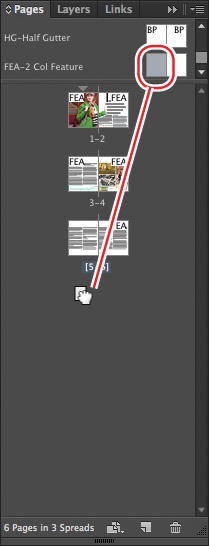
InDesign automatically subdivides the text frame into two threaded text frames of equal width.
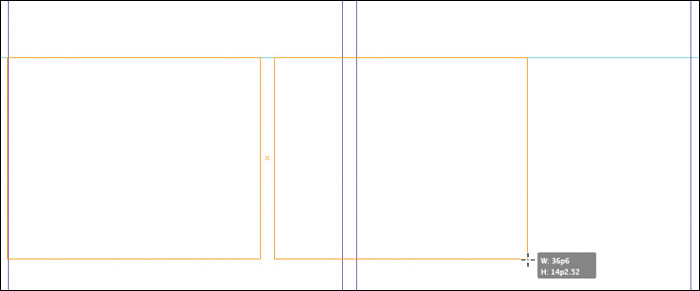
When the loaded text icon is over an empty text frame, a chain icon indicates that you can thread to that frame. You can also flow overset text into an empty graphics frame; the graphics frame is automatically converted to a text frame.
7. Scroll up to see the bottom of page 6.
8. Using the Selection tool (![]() ), click to select the text frame in the second column on page 6. Then, click its out port in the lower-right corner to load the text icon with the overset text.
), click to select the text frame in the second column on page 6. Then, click its out port in the lower-right corner to load the text icon with the overset text.
9. Scroll down to page 7. Click the loaded text icon (![]() ) in the text frame in the first column.
) in the text frame in the first column.
The text flows through the two linked text frames. If necessary, use the Selection tool to resize and reposition the two text frames within the column guides.
10. Choose File > Save. Leave the page in this position for the next exercise.
Resizing text frames automatically
While adding, deleting, and editing text, you often end up resizing text frames. With the InDesign Auto-Size feature, you can specify that a text frame resize itself automatically according to your specifications.
![]() Tip
Tip
The Auto-Size feature is ideal for individual text frames with a stroke and/or fill providing a boundary for the text (for example, a sidebar or coupon). If the text gets shorter, the frame gets smaller as well. If the text gets longer, it does not end up overset.
You will now use the Auto-Size feature to automatically adjust the size of the last text frame based on the length of the text.
1. Using the Selection tool (![]() ), click in the text frame in the second column at the right on page 7. Choose Object > Text Frame Options.
), click in the text frame in the second column at the right on page 7. Choose Object > Text Frame Options.
2. In the Text Frame Options dialog box, click the Auto-Size tab. From the Auto-Sizing menu, select Height Only.
3. Click the center icon in the top row (![]() ) to indicate that you want the text frame to “grow down” as if you were manually dragging the bottom handle of the text frame down. Click OK.
) to indicate that you want the text frame to “grow down” as if you were manually dragging the bottom handle of the text frame down. Click OK.
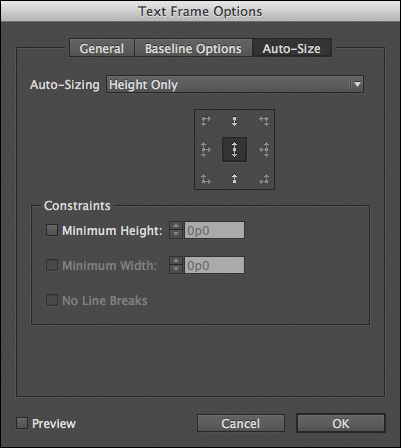
4. Using the Selection tool, click to select the text frame at the left. Drag the center handle on the bottom of the text frame up to decrease the frame’s size.
The text reflows to the second column and the size of that text frame automatically expands.
Once you place a file into a layout, the writers and editors should stop working on their copy of the file. This is because, by default, InDesign does not retain a link to a placed .docx file. Retaining and updating a link to the source text file could result in the loss of text formatting applied by the designer or create overset text. Therefore, any additional text edits are made by the designer in the InDesign layout.
5. Using the Type tool (![]() ), click at the end of the text after “France” and the period. Press Enter or Return multiple times to see how the text frame expands.
), click at the end of the text after “France” and the period. Press Enter or Return multiple times to see how the text frame expands.
6. Leave the columns in any position you like—as long as there is no text overflow.
7. Choose Edit > Deselect All, then choose File > Save.

Adding a jump line page number
When a story continues across multiple pages, forcing readers to turn pages, it helps to add a jump line such as “(Continued on page x).” You can create jump lines in InDesign that automatically reflect the number of the next page in the text flow (that is, the next page the text frame is linked to).
1. Double-click the page 2 icon in the Pages panel to center the page in the document window. Scroll to the right to view a portion of the pasteboard. Zoom in as necessary to see the text.
2. Using the Type tool (![]() ) and working on the pasteboard, drag to create a text frame that is approximately 17 by 3 picas.
) and working on the pasteboard, drag to create a text frame that is approximately 17 by 3 picas.

3. Using the Selection tool (![]() ), drag the new text frame to the bottom of the second column on page 2. Be sure the top of the new text frame touches the bottom of the existing text frame.
), drag the new text frame to the bottom of the second column on page 2. Be sure the top of the new text frame touches the bottom of the existing text frame.

4. Using the Type tool, click to place an insertion point in the new frame. Type Bikes continued on followed by a space.
![]() Note
Note
For the Next Page Number character to work properly, the text frame containing the jump line must touch or overlap the threaded frame.
5. Choose Type > Insert Special Character > Markers > Next Page Number. The jump line now reads “Bikes continued on 3.”

6. Choose Type > Paragraph Styles to open the Paragraph Styles panel. With the text insertion point still in the jump line, click the Continued From/To Line paragraph style to format the text according to the template.

7. Choose File > Save.
8. Choose View > Fit Spread In Window.
9. Choose Preview from the Screen Mode menu in the Application bar at the top of the screen.
Congratulations, you have finished the lesson.
Exploring on your own
In this lesson, you learned how to create a jump line that indicates the page number that a story continues on. You can also create a jump line that indicates the page number that a continued story came from.
![]() Tip
Tip
Experiment with text-flowing options to find out what threading methods work best for you and your projects. For example, if you are creating a template for a catalog, you might thread several small text frames for item descriptions, and then flow the text later.
1. Using the Selection tool (![]() ), duplicate the text frame containing the jump line on page 2. (To duplicate an object, select it and choose Edit > Copy.)
), duplicate the text frame containing the jump line on page 2. (To duplicate an object, select it and choose Edit > Copy.)
2. Paste the jump line text frame on page 3. Drag the text frame so that it touches the top of the text frame in the first column.
3. Using the Type tool (![]() ), change the words in the text frame from “Bikes continued on” to “Bikes continued from.”
), change the words in the text frame from “Bikes continued on” to “Bikes continued from.”
4. Select the page number, 3, in the jump line.
At this point, you need to replace the Next Page Number character with the Previous Page Number character.
5. Choose Type > Insert Special Character > Markers > Previous Page Number.
The jump line now reads “Bikes continued from 2.”
Review questions
1. Which tool lets you thread text frames?
2. How do you load the text icon?
3. What happens when you click the loaded text icon between column guides?
4. Which key do you press to automatically divide a text frame into multiple threaded frames?
5. What is the name of the feature that automatically adds pages and threaded text frames to contain all the text in an imported text file?
6. What feature automatically adjusts the size of a text frame based on the length of the text?
7. What do you need to do to ensure that the Next Page Number and Previous Page Number characters work in a jump line?
Review answers
1. The Selection tool.
2. Choose File > Place and select a text file, or click in an out port that contains overset text. You can also drag text files from the desktop onto a page.
3. InDesign creates a text frame where you click; the frame fits within the vertical column guides.
4. Press the Right Arrow key as you drag to create a text frame. (You can also press the Left Arrow key to decrease the number of columns as you create a text frame.)
5. Smart Text Reflow.
6. The Auto-Size feature, found in the Text Frame Options dialog box (Object menu).
7. The text frame containing the jump line must touch the threaded text frame containing the story.

